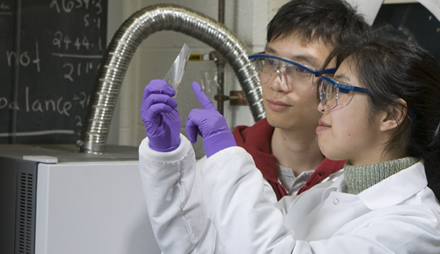 What if a bandage could do more than just cover up a wound? What if it could help you to heal by dispensing medicine and scrubbing away bacteria? What if this technology were so cheap you could throw it away when you were done? These are questions doctoral student Dylan Farnam grapples with as he attempts to design a better bandage.
What if a bandage could do more than just cover up a wound? What if it could help you to heal by dispensing medicine and scrubbing away bacteria? What if this technology were so cheap you could throw it away when you were done? These are questions doctoral student Dylan Farnam grapples with as he attempts to design a better bandage.
“A device such as this can be used by soldiers in the field, in disaster relief and in the hospital setting for treating wounds that take months or years to heal,” Farnam said. “Limbs that may otherwise become infected and have to be removed can be saved, and lives can be saved.”
Farnam’s research is funded by a fellowship called the IGERT, or Integrative Graduate Education and Research Traineeship. The National Science Foundation awarded $2.5 million to Binghamton University, Cornell University and Albany’s Wadsworth Center. From 2007 to 2012, Binghamton’s $500,000 portion of the award supports student research focusing on the medical applications of flexible electronics.
Mary Beth Curtin, associate director of the Small Scale Systems Integration and Packaging Center (S3IP), said this the first time Binghamton has received an IGERT award. “There’s a lot of promise in flexible electronics — it’s a brand-new field,” she said. “That’s one reason why this award is so exciting for our students.”
The project at Binghamton is led by professors Bahgat Sammakia and Omowunmi Sadik, each of whom nominates graduate students to be funded by the IGERT. For the students, that means a $30,000 yearly stipend in addition to tuition coverage, an expenses-paid study-abroad experience and funding for research materials.
IGERT fellow Nian Du’s work is spurred by rising concerns over the environmental impact of silver nanoparticles — microscopic bits of metal used in a variety of medical applications as well as consumer products. Once touted as wonderful applications of modern technology, nanoparticles’ potential to enter the water supply and penetrate human tissue now worry scientists. If they do turn out to be harmful, Du plans to be ready with a substance that can detect and filter nanoparticles.
Leo Zheng, Binghamton’s newest IGERT fellow, is working with Farnam on the mechanics of the smart bandage. He will design a flexible sensor that can be used to detect undesirable bacteria in places such as public water supply piping.
Although Farnam, Du and Zheng work independently on their research, they certainly aren’t working alone. Along with the IGERT fellows from Cornell and the Wadsworth Center, they take a myriad of classes, from analytical chemistry and biology to materials science and marketing. As a key aspect of the program, fellows from disciplines as diverse as chemistry, biophysics, mechanical engineering and neuroscience gather for seminars and webinars to discuss their research and exchange ideas.
James Turner, research scientist at S3IP and co-writer of the IGERT application, explained that such multidisciplinary collaborations “open up a wealth of possibilities, by bringing together multiple science and engineering approaches to solve a problem in a unique way that maybe wouldn’t otherwise be possible.”
The program’s interdisciplinary nature makes her current research more effective, Du said. “I will have a broader background than others when I graduate,” she added, “and this will give me more preparation for all kinds of jobs.”
IGERT fellows are also learning to collaborate on a global scale through international internships. As part of the IGERT, Farnam is working in Sydney, Australia, with a researcher who specializes in making coatings that prevent microbial buildup on items such as medical implants and contact lenses. “This way I can learn a lot about the biological side of my research, since I specialize in the mechanics,” he said. “In addition, I get to experience how things are done in a different educational system and by a research group in a different field than mine.”
Turner said this global view is a real advantage. “To have students with the experience to interact with people from different cultures, who may have different priorities and perspectives on the world and the role of science in that world, is extremely important,” he said, “and will be more so in the future.”
The IGERT has lead to research collaborations with several departments at Cornell, Curtin said, and this has improved overall research quality. She said that the world of science is seeing a trend toward multi-institutional and multidisciplinary collaboration. “That’s a good thing,” she added, “because it has helped Binghamton to develop partnerships across the nation, which infuse our area with new and different viewpoints.”







